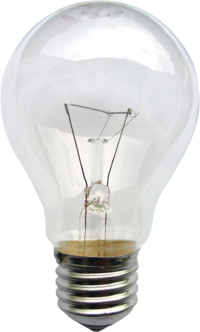
Photo from wikipedia
ABSTRACT In order to study the impact of exposure to tungsten aerosol on brain toxicity, we designed a strategy to control the generation of tungsten aerosol with mass concentrations within… Click to show full abstract
ABSTRACT In order to study the impact of exposure to tungsten aerosol on brain toxicity, we designed a strategy to control the generation of tungsten aerosol with mass concentrations within the magnitude of the average occupational exposure limit value (5 to 10 mg.m-3). Due to such extreme density of tungsten particles, the challenge was to perform relevant measurements of aerosol characteristics needed for upper airways and lung deposition calculations. We mixed tungsten bead powder of coarse diameter with the powder of interest in well-defined mass proportions. We used a cyclone at the exit of a RBG 1000 generator (PALAS) to remove the coarse particles from the aerosol of interest. Measurements of aerosols produced in the inhalation chamber were carried out using several instruments paired with sample lines arranged symmetrically: a low pressure impactor DLPI-30 lpm Dekati® with a basic sampling on filter holder; a DLPI with an APS (Aerodynamic Particle Sizer) 3321 TSI®; an EEPS (Engine Exhaust Particle Sizer) 3090 TSI® with an APS. The DLPI and the filter holder always provided very close measurements in terms of mass concentrations. The mass median aerodynamic diameter (Da) was 1.77 and 1.89 µm as determined by the DLPI and the APS with the Stokes correction, respectively. The count median diameter in electrical mobility determined by EEPS was 0.17 µm. The results obtained show very good agreement between the measurements carried out with the DLPI, APS and EEPS. The methodology developed for the analysis of the EEPS results confirms that the measurements of the electrical mobility diameter made with this instrument is within a range of aerodynamic sizes never explored and for which the instrument was not initially designed. CFD simulations of the airflows and aerosol dispersion in the chamber allowed to ensure that the aerosol inhaled by the animals is homogeneous and representative.
Journal Title: Aerosol and Air Quality Research
Year Published: 2021
Link to full text (if available)
Share on Social Media: Sign Up to like & get
recommendations!